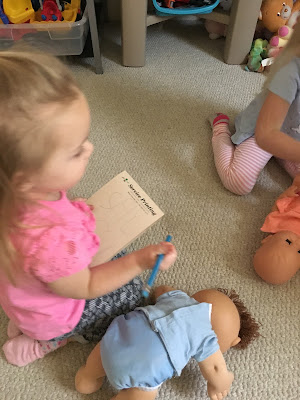We had a great first week learning about ourselves and others! Our Small Group work this week included reading
Faces by Sue Clark and examining our facial features in the mirror. We talked about the various colors we could see, feelings we could communicate, and parts of our faces. Friend "Z" observed that she had to turn her face sideways to see her ears, because not all of our parts are on the front of our faces.
Then we were given a blank face, and markers, pasta, wiki-sticks, jewels, googly eyes, and feathers to make our faces with art.
Here is our class collection of portraits! The children used the materials creatively, using wiki-sticks to make curly or poky hair, pasta or feathers to make mouths, jewels to make eyes, etc. Some children chose to use googly eyes and sorted through the eyes to find two that matched. Each child decided on only having two eyes in their artwork because that was what they noticed in the mirror.

It is important to make note of the child's words and efforts during their table time in order to document the learning that happened. The amount of focus, fine motor skills, creativity, and language used during this activity was important and exciting!
During Work Time, the children worked on plans of their own choosing. Friend K worked on balancing bears of multiple sizes. She experimented with putting different sizes and different amounts of bears in the scale buckets to see which was heavier.

We also used CareBears, fabric and cotton balls to make bear beds, and worked many puzzles, lacing beads, and Gears in the Toy and Puzzle Area.
Then we moved onto plans in the House Area and Block Area. Babies needed bathing, doctoring, and dressing! Roads were built, tools were used, and Little People vans were loaded with passengers.
We finished up by chatting on telephones to report what our favorite part of the day was. We read a book about how wonderful we are as individuals, not like anyone else! Then we played a game where we heard various animal or environmental sounds, and practiced listening, and then saying what we heard. Using our ears is an important part of being a good friend and participating in the classroom.
















































